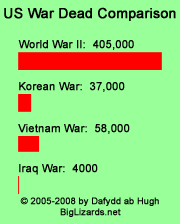October 27, 2010
On the Other Hand...
I may have turned unduly pessimistic about the California gubernatorial vote too quickly. Clearly Republican Meg Whitman is running behind her cohort running for U.S. Senate, Carly Fiorina; but that doesn't necessarily mean Whitman should be out of the running, as the polling implies. There are several indicators that, as Elmer Fudd was wont to say, "there's something awfuwy scwewy going on heah!"
In the first place, let's take a step back from the trees to contemplate the forest for a moment. Why would the entire rest of the country be experiencing a Republican wave... but California be strongly surging to the Democrats? It's not completely impossible, but it does seem rather unlikely.
In those cases elsewhere in which the Republican is losing, it's nearly always because he has huge problems with money and with making crazy, radical statements; for example, Christine O'Donnell in Delaware. But the GOP candidates for governor (former eBay CEO Meg Whitman) and U.S. senator (former Hewlett-Packard CEO Carly Fiorina) are both (a) extremely well-heeled and self-financing, and (b) more center-right than Tea Party, which in a blue state like California should make them more attractive, not less.
I could see a situation where they were neck and neck instead of surging ahead, as in the rest of the country; but why would the retread Democrats they face -- former Gov. Jerry Brown and current incumbent Sen. Barbara Boxer (D-CA, 100%) -- be the ones surging ahead?
Now let's look at those polls more closely.
In an election, everything depends upon turnout; and the accuracy of the polling critically depends upon the turnout model used by the pollster.
Columnist Sean Trende at Real Clear Politics has a few words to say on that subject:
If you follow California Senate polling closely, you have to be feeling a little bit nauseated from the roller coaster ride you've been on. Some polls are showing Senator Barabara Boxer with a comfortable 9-point lead and above 50 percent, while others are showing a much closer race. One Republican pollster even shows Fiorina ahead.
What is going on here? The answer is something I've discussed before: Pollsters are having a devil of a time agreeing on what the electorate is going to look like.
Trende has a chart comparing the turnout models used by various polls from a week ago to the leads enjoyed by the Democrat in the Senate race, incumbent Sen. Barbara Boxer (D-CA, 100%). Not surprisingly, he finds a strong correlation between a turnout model that predicts a very high Democratic edge over Republicans in voting -- and a much larger lead by Boxer (duh).
But is more intriguing (and puzzling) to compare the turnout models to the actual results of two previous elections in California, the 2006 mid-term and the 2008 presidential election. 2006 was a big election year for Democrats: The party picked up six Senate seats and 31 House seats nationwide. In California, according to Trende's chart, exit polling showed that Democrats had a +6% edge over Republicans in turnout at the polls.
2008 was equally big for the Democrats: Democrats picked up eight Senate seats and 21 House seats. But in California, the partisan turnout edge for Democrats was double that of the 2006 election (and the 2004 election as well), a full 12%.
Note that this doesn't count early voting by mail-in balloting; but Republicans were pushing mail-in voting far more than Democrats in 2006, so Republican strength was likely underrepresented in that survey, compared to Democrats. However in 2008, Democrats had a huge and very successful mail-in voting drive, meaning they were even more undercounted in exit polls than Republicans had been two years earlier. That means the gain in partisan edge in California, from 6% to 12%, is probably understated: Democrats likely increased their lead in the Golden State by more than the 6% increase derived from the exit polling.
Now let's look at the correlation with the polling this year. Of the six pollsters who report the partisan breakdown of respondents in their polling (Rasmussen does not, for example), two (SurveyUSA and Reuters) show a Democratic edge of 6% - 7%. In other words, these two pollsters believe turnout in California is going to be pretty much like 2004 and 2006; and they show an average lead for Boxer over Fiorina of 1.5%. (Remember, this is according to the polling a week ago, the only polls for which we really have a good partisan cross-tab.)
But the other four -- Suffolk, PPP (a Democratic poll), the L.A. Times, and PPIC -- show a Democratic partisan edge of 12% - 14% in their turnout model. These four pollsters believe the partisan turnout in 2010 will mirror the turnout in 2008, that Democrats will have just as big or even bigger a turnout edge this year than the year Barack H. Obama ran for the presidency. Not surprisingly, they show a much higher average lead for Boxer over Fiorina of 7.8%.
They believe 2010 will just as big a Democratic wave election as 2008; does that make sense to anyone here?
The problem may well be the filtering question used to decide which respondents are "likely voters." Some pollsters use a very simple system: They ask respondents whether they voted in either of the last two elections, and whether they're sure they'll vote this time. Others have a more stringent likely voter test. But the loose test virtually quarantees that when the pollster picks the respondents to report as "likely voters," the turnout model will mirror 2008 -- because everyone who voted in 2008 (or thinks he did) becomes a "likely voter" for 2010.
It is, however, a very unlikely scenario in real life: This is not a huge Democratic wave election, as 2008 was; it's not even a wave election like 2006. In reality, it appears to be a massive Republican wave election, like 1994.
If anything, the Democratic edge over Republicans, even in California, should be lower than in 2006 and 2004. In all probability, even SurveyUSA and Reuters are overestimating the Democratic lead; and the other four pollsters are dramatically overestimating it. And if they're overestimating Democratic voters in the Senate race, they're simultaneously overestimating them on the governer's race, as well.
But what about the current SurveyUSA poll, released today, which shows Boxer jumping from a 2-point lead on the previous survey, October 19th, to a 5-point lead now; and for governor, Democrat Jerry Brown edging up from a 7-point lead on the 19th to an 8-point lead now? It turns out that SurveyUSA has its own special potential problem.
(To see the raw numers instead of percentages on these two SurveyUSA polls, click the drop-down on the left and select "Show Counts (Frequencies)" instead of "Show Percentages".)
First of all, the turnout model for the new survey -- that is, the partisan breakdown of respondents they choose to call likely voters -- jumped up from a 7.2% Democratic edge on the 19th to an 8.4% edge on the 26th, moving significantly closer to the 2008 model than a week earlier.
Then I began looking into the internals (and kudos to SurveyUSA for making them available to ordinary readers), and I noticed a curious phenomenon: In the previous poll, 7% of the "likely voters" (as determined by SurveyUSA) contacted by telephone only have cell phones, no landlines. But in the current poll, just one week later, that number lurches wildly upwards to 25% of the "likely voters," 3.6 times as high. Wow!
I find that very flakey; while a number of young adults only have cell phones, I suspect they are much less likely actually to vote (and SurveyUSA agrees); for one thing, it's very difficult for the parties to find those voters in order to talk to them face to face in a get-out-the-vote (GOTV) effort. In fact, we can't even know for sure whether they even reside in California and can vote here at all!
When you recalculate the current survey, using only those likely voters who have a landline (regardless of whether they were contacted by cell or landline), the numbers change dramatically.
First the Senate race:
| Candidate | Total # | Total % | Land # | Land % |
|---|---|---|---|---|
| Boxer | 266 | 44.8 | 202 | 45.6 |
| Fiorina | 240 | 4.04 | 199 | 44.9 |
| Total | 594 | B-F = 4.5 | 443 | B-F = 0.7 |
In other words, with the cell-only respondents included, Carly Fiorina is down to Barbara Boxer by 4.5%; but looking only at those respondents who actually have a landline (even if they also have a cell phone), she is only down by 0.7%. That's one heck of a difference, moving from leaning towards Boxer to a complete toss-up!
Let's look at the governor's race:
| Candidate | Total # | Total % | Land # | Land % |
|---|---|---|---|---|
| Brown | 275 | 46.3 | 208 | 47.0 |
| Whitman | 225 | 37.9 | 188 | 42.4 |
| Total | 594 | B-W = 8.4 | 443 | B-W = 4.6 |
We see exactly the same phenomenon in this case: With the cell-only respondents, Whitman is behind Brown by a powerful 8.4%; but looking only at respondents with landlines, she is only down by 4.6%, putting her solidly within striking range via a number of factors (GOTV; the wave effect -- voters in California get to see results back east before they vote, which could discourage Democrats from voting; a bad turnout model -- SurveyUSA gives an 8.4% edge to Democrats in their model, when they may only get a 6% or even lower in the actual election; and so forth).
So there still appears to be many severe problems with polling in California, problems that appear to be much worse than polling problems in other states. For that reason, I retract my prediction of doom for Meg Whitman in favor of no prediction at all. The polling is simply too wonky to trust.
Hatched by Dafydd on this day, October 27, 2010, at the time of 4:56 PM
Trackback Pings
TrackBack URL for this hissing: http://biglizards.net/mt3.36/earendiltrack.cgi/4641
Comments
The following hissed in response by: Geoman
I refuse...REFUSE...to believe that even the voters of California are retarded enough to re-elect Brown and Boxer. Brown was a disaster as governor. Boxer is arguably the stupidest person in the Senate. My objection to these two goes well past any objection I might have to their policies - they are both objectionable based on poor intelligence and temperament.
Now, if I had to choose. Choose just one to loose...I'd pick Boxer. California is screwed no matter who is governor, but a decent senator might save the country.
The above hissed in response by: Geoman ![[TypeKey Profile Page]](../../../../blog/nav-commenters.gif) at October 28, 2010 10:46 AM
at October 28, 2010 10:46 AM
Post a comment
Thanks for hissing in, . Now you can slither in with a comment, o wise. (sign out)
(If you haven't hissed a comment here before, you may need to be approved by the site owner before your comment will appear. Until then, it won't appear on the entry. Hang loose; don't shed your skin!)© 2005-2009 by Dafydd ab Hugh - All Rights Reserved










